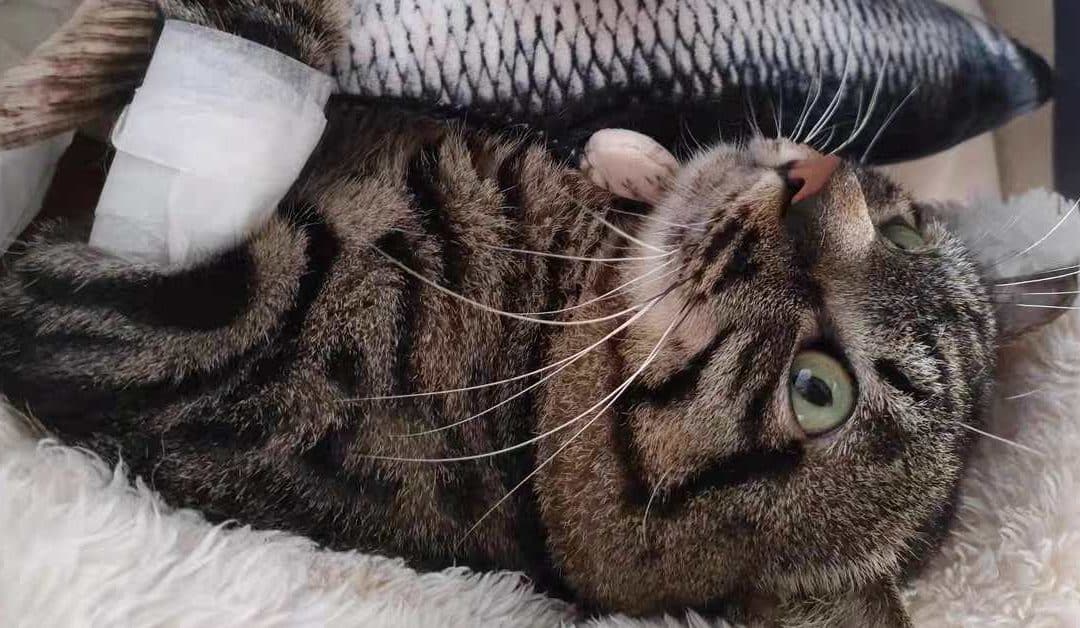
by Dr. Faith Whitehead | Nov 11, 2022 | Research and News, Cat Cancer & Tumors, Dog Cancer & Tumors, Food & Health, Medicines & Therapies, pet Chinese herbal medicine
Pets play an important role in TCM, where they are often used as therapy animals. In traditional TCM, there are four main categories of therapy animals: domestic animals, wild animals, insects, and reptiles. Each category has different therapeutic effects and is used for different purposes. Pets can be used to treat a wide variety of conditions, including anxiety, depression, stress, insomnia, and chronic pain. They can also be used to improve circulation, boost the immune system, and promote healing. There are a variety of ways to use pets in Chinese medicine. Common methods include acupuncture, moxibustion, cupping, and massage. Acupuncture is a form of Chinese medicine that involves inserting thin needles into the skin at specific points on the body. It is used to treat a wide variety of conditions, including pain, anxiety, nausea, and migraines. Moxibustion is a form of Chinese medicine that involves burning dried mugwort (Artemisia argyi) on or near the skin. It is used to treat a variety of conditions, including pain, inflammation, and menstrual cramps. Cupping is a form of Chinese medicine that involves placing glass cups on the skin and creating a vacuum. This vacuum pulls the skin and muscles upwards, which is said to improve circulation and relieve pain. Massage is a form of Chinese medicine that involves rubbing, kneading, or stroking the skin with the hands. It is used to treat a variety.
Domestic animals, such as dogs and cats, are the most commonly used therapy animals in China. They are often used in hospitals and nursing homes to help patients recover from illness and injury. Dogs are especially popular, as they are believed to have a special ability to sense and respond to human emotions. Therapy animals can provide companionship, emotional support, and physical contact to people who are lonely, sick, or injured. They can also help people to coping with anxiety, stress, and depression. Therapy animals can be used in a variety of settings, including hospitals, nursing homes, schools, prisons, and shelters. There is no formal training or certification required for therapy animals in China. However, animals must be healthy and have a good temperament in order to be considered for therapy work.
Wild animals, such as tigers and bears, are also used in Chinese medicine, but they are less common than domestic animals. Wild animals are thought to have more powerful therapeutic effects than domestic animals, and they are often used to treat more serious conditions. There are a number of different ways that wild animals can be used in traditional Chinese medicine. They can be used whole, or in parts, and can be consumed orally, applied topically, or injected. One of the most common ways that wild animals are used in traditional Chinese medicine is through the consumption of their body parts. This can be done by eating the meat, organs, or other tissues of the animal, or by drinking its blood. Wild animals are also sometimes used in traditional Chinese medicine through the application of their body parts to the skin. This can be done by rubbing the body part on the skin, or by applying it as a poultice. In some cases, wild animals are used in traditional Chinese medicine through injections. This is usually done with the help of acupuncture needles, which are inserted into specific points on the body. There are a number of different benefits that are associated with the use of wild animals in traditional Chinese medicine. For example, it is believed that they can help to improve circulation, reduce inflammation, and relieve pain. Wild animals are also thought to be able to improve the function of the immune system, and to help to fight off infections.
Insects, such as bees and silkworms, are also used in Chinese medicine. Insects are believed to have a range of therapeutic effects, including the ability to reduce inflammation and pain. Reptiles, such as snakes and lizards, are also used in Chinese medicine. Reptiles are thought to have powerful therapeutic effects, and they are often used to treat serious conditions. In addition to animals, Chinese medicine also uses a variety of plant-based substances. Herbs are the most commonly used plant-based substances in Chinese medicine. Chinese herbs are often used to treat a wide variety of conditions, including pain, inflammation, and digestion problems. A wide variety of plant-based substances are used in Chinese medicine, including roots, leaves, flowers, and bark.Many intractable diseases can be treated with a combination of traditional Chinese and Western medicine.
About the author: Dr. Faith Whitehead; is a licensed veterinarian and researcher.

by Dr. Faith Whitehead | Nov 11, 2022 | Dog Cancer & Tumors, Medicines & Therapies, Research and News
There is a great deal of ongoing research into the causes and treatment of dog cancer. Some of the most promising recent discoveries include: Firstly, a study published in the journal Carcinogenesis in March 2015 found that dogs fed a diet high in antioxidants and omega-3 fatty acids had a lower risk of developing cancer. Secondly, a study published in the journal PLoS One in January 2015 found that dogs with high levels of the enzyme lipoxygenase were more likely to develop cancer. Thirdly, a study published in the journal Nature in September 2014 found that a protein called SIRT6 protects against cancer by stopping cells from dividing. Fourthly, study published in the journal Science in June 2014 found that a drug called metformin may help to prevent cancer by slowing the growth of cancer cells. A study published in the journal Nature in May 2014 found that a protein called p53 helps to prevent cancer by stopping cells from dividing. Furthermore, a study published in the journal Nature in January 2014 found that a protein called BRCA1 helps to prevent cancer by repairing damaged DNA. A study published in the journal Science in December 2013 found that a drug called rapamycin may help to prevent cancer by slowing the growth of cancer cells. Lastly, a study published in the journal Nature in October 2013 found that a protein called PTEN helps to prevent cancer by stopping cells from dividing.
The American Kennel Club’s Canine Health Foundation is funding a study on the genetics of mast cell tumors in dogs, which will hopefully provide information on the causes and possible treatments of this type of cancer. The Canine Health Foundation is also funding a study that looks at the genetics of mast cell tumors in dogs. The hope is that this study will provide information on the causes and possible treatments of this type of cancer. These research have hypothesized the following: A possible link between certain breeds of dogs and a higher risk of developing cancer -A possible link between early spaying/neutering and a decreased risk of developing cancer. Some of the latest research on dog cancer includes studies on new treatments, such as immunotherapy and targeted therapy. Clinical trials are ongoing for many of these new treatments, so talk to your veterinarian about whether or not your dog may be a good candidate.
A study published in 2019 in the Journal of the American Veterinary Medical Association found that immunotherapy, also known as biologic therapy, was associated with a significant increase in survival time for dogs with lymphoma. The study looked at data from 2,200 dogs with lymphoma treated at 24 veterinary oncology centers. The median survival time for dogs that received immunotherapy was 386 days, compared to 172 days for dogs that did not receive immunotherapy. Another study published in 2020 in the Journal of Veterinary Internal Medicine examined the use of immunotherapy for dogs with osteosarcoma. The study found that immunotherapy increased survival time for dogs with osteosarcoma and also improved quality of life. The median survival time for dogs that received immunotherapy was 365 days, compared to 240 days for dogs that did not receive immunotherapy. Lastly, a study published in 2019 in the journal Cancer Cell looked at the use of a targeted therapy drug called toceranib phosphate (Palladia) for the treatment of dogs with mast cell tumors. The study found that toceranib phosphate was associated with a significant increase in survival time for dogs with mast cell tumors. The median survival time for dogs that received toceranib phosphate was 365 days.
Latest research indicate that a new treatment for dog cancer, called immunotherapy, is showing promising results. The treatment uses the dog’s own immune system to fight the cancer. A new drug called Palladia is showing promise as a treatment for dog cancer. Palladia targets a protein that is specific to cancer cells, and it has been shown to kill cancer cells in dogs. Palladia is currently being tested in clinical trials, and it is not yet available for general use. However, it is possible that the drug may be approved for use in the future. Palladia is not the only immunotherapy drug that is showing promise as a treatment for dog cancer. Another immunotherapy drug, called toceranib, is also being tested in clinical trials. Toceranib targets a different protein that is specific to cancer cells, and it has also been shown to kill cancer cells in dogs.
About the author: Dr. Faith Whitehead; is a licensed veterinarian and researcher.

by Dr. Faith Whitehead | Nov 11, 2022 | Medicines & Therapies, Research and News
Homeopathic veterinary medicine is a branch of alternative medicine that uses very small doses of natural substances to treat a variety of conditions in animals. Homeopathic remedies are prepared by a process of diluting and shaking the substance to create a “potentiated” solution. It can also be termed as a system of medicine that is based on the principle of “like cures like.” That is, a substance that can cause symptoms in a healthy person can be used to treat those same symptoms in an ill person. Homeopathic remedies are usually prepared by diluting a substance in water or alcohol and then administering it in very small doses. Homeopathic practitioners believe that this process helps to release the healing energy of the substance and that the body can then use this energy to heal itself.
Homeopathic veterinary medicine is used to treat animals holistically, taking into account the animal’s physical, mental, and emotional health. This approach is based on the belief that the whole animal must be treated, not just the symptoms of the disease. Homeopathic veterinary medicine is gentle, safe, and effective, and can be used to treat a wide variety of conditions. Homeopathic remedies are often very effective in treating chronic conditions that are difficult to treat with conventional medicine. Homeopathic remedies are gentle and can be used for a very long time with no side effects. Homeopathic remedies are safe for everyone, including infants, children, pregnant women, and the elderly. Homeopathic remedies are made from very small amounts of natural substances. Homeopathic remedies are prepared in a special way that makes them very potent. Homeopathic remedies are taken by mouth in pill or liquid form. The best way to find a homeopathic remedy that works for you is to consult with a trained homeopath. Homeopathic remedies are available over the counter at health food stores and online.
There is no scientific evidence to support the efficacy of homeopathic veterinary medicine in pets. The available evidence does not support the claim that homeopathic products are effective for treating any health condition in animals. Veterinary patients should be treated with conventional medicine, based on the best available scientific evidence. A 2008 systematic review of homeopathy as a treatment for any condition in humans or animals concluded that there is no reliable evidence for the efficacy of homeopathy. A 2010 review of the efficacy of homeopathy for treating health conditions in animals found limited evidence from a small number of trials that homeopathic treatments may be clinically effective for some animal health conditions. A 2012 study of homeopathic treatment of dairy cows found no clinical evidence of efficacy, and suggested that the placebo effect may have played a role in the reported positive results.
The claim that homeopathic remedies can effectively treat cats and dogs is considered false. However, some homeopathic practitioners say that their products have helped pets with various health problems. There is also anecdotal evidence that some pets have responded positively to homeopathic treatments. If you’re considering using homeopathic remedies for your pet, it’s important to consult with your veterinarian first. They can advise you on whether or not a particular remedy is likely to be effective for your pet’s condition.
About the author: Dr. Faith Whitehead; is a licensed veterinarian and researcher.

by Dr. Faith Whitehead | Nov 11, 2022 | Cat Cancer & Tumors, Dog Cancer & Tumors, Food & Health, Medicines & Therapies, Pet Story, Research and News
Euthanasia is the humane process of ending an animal’s life in order to relieve pain and suffering. The decision to euthanize a pet is a difficult one, but sometimes it is the most humane option. If you are considering euthanasia for your pet, it is important to consult with your veterinarian to discuss all of your options and to make sure that you are making the best decision for your pet. Veterinarians may perform euthanasia on pets for a variety of reasons. The most common reason is when a pet is suffering from a terminal illness and the owner does not want the pet to continue to suffer. Other reasons for euthanasia include when a pet is aggressive and poses a danger to others, when a pet is severely injured and cannot be healed, or when an owner can no longer afford to care for the pet.
There are a number of procedures that can be used for euthanasia in pets, and the support given will depend on the individual pet and owner. Some common procedures include injecting a lethal dose of an anesthetic agent, such as euthanasia solution, into the vein or muscle; asphyxiation using carbon dioxide; or administration of a high dose of barbiturates. The owner may be present during the procedure, and the pet will usually be placed on a table or in a quiet room to minimize stress. After the pet is euthanized, the body will be removed and the owner may be given time to say goodbye.
The pros of going forward with euthanasia in pets is that it can provide a peaceful death for a pet that is suffering from a terminal illness or has a poor quality of life. It can also spare the pet’s owner from having to witness the pet’s decline and suffering. The cons of going forward with euthanasia in pets is that it is a permanent solution and can be emotionally devastating for the pet’s owner. Some people may feel that euthanasia is a good idea in certain situations, such as when a pet is suffering from a terminal illness and is in pain, while others may believe that it is never acceptable to end a pet’s life. Ultimately, the decision of whether or not to euthanize a pet is a personal one that should be made by the pet’s owner in consultation with a veterinarian.
There are a few things to keep in mind when considering euthanasia for a pet. First, make sure that you have a good reason for doing so. Euthanasia should only be considered when a pet is suffering from a terminal illness or is in pain that cannot be alleviated. Second, be sure to consult with a veterinarian before making a decision. They will be able to advise you on whether or not euthanasia is the best option for your pet. Finally, be prepared for the emotional fallout that comes with euthanasia. This is a difficult decision to make, and it is important to be prepared for the grief that comes afterwards.

by Dr. Faith Whitehead | Nov 11, 2022 | Cat Cancer & Tumors, Dog Cancer & Tumors, Medicines & Therapies, Research and News
Drugs are an important part of treating dog tumors and cancers. Without drugs, many treatments would not be possible. Drugs are used to treat the tumor directly, as well as to treat side effects of treatments. Antibiotics are used to treat infections, and anti-nausea drugs are used to prevent and treat nausea and vomiting. Pain medications are used to control pain, and anti-inflammatory drugs are used to reduce inflammation. Many treatments are only possible using drugs. This includes chemotherapy, radiation therapy, and immunotherapy. These are treatments that are only available using drugs. There are other treatments available using drugs as well. This includes hormone therapy, targeted therapy, and biologic therapy. These therapies can be used in conjunction with other treatments to provide the most effective treatment possible.
There are a number of drugs that are effective in treating dog tumors and cancers. The most common are chemotherapy drugs, which work by killing cancer cells. Other drugs that may be used include radiation therapy, immunotherapy, and targeted therapy. Chemotherapy is the most common treatment for dog tumors and cancers. Chemotherapy drugs work by killing cancer cells. The most common chemotherapy drugs used to treat dog tumors and cancers are carboplatin, doxorubicin, and vincristine. Carboplatin is a platinum-based chemotherapy drug that works by interfering with the cancer cells’ ability to divide. Doxorubicin is an anthracycline chemotherapy drug that works by intercalating DNA and inhibiting topoisomerase II. Vincristine is a vinca alkaloid chemotherapy drug that works by binding to tubulin and inhibiting microtubule assembly. Radiation therapy is another treatment option for dog tumors and cancers. Radiation therapy works by damaging the DNA of cancer cells, which prevents them from dividing. The most common type of radiation therapy used to treat dog tumors and cancers is external beam radiation therapy. External beam radiation therapy is a type of radiation therapy that uses a machine to direct high-energy beams at cancer cells. There are two types of external beam radiation therapy: 1. Photon therapy: Photon therapy uses high-energy X-rays to kill cancer cells. 2. Proton therapy: Proton therapy uses beams of high-energy protons to kill cancer cells. Proton therapy is newer and may have fewer side effects than photon therapy.
Chemotherapy is a type of drug treatment that uses chemicals to kill cancer cells. Chemotherapy can be given intravenously (through a vein) or orally (by mouth). Chemotherapy is often used in combination with other treatments, such as surgery or radiation therapy. Chemotherapy is usually given in cycles, with each cycle consisting of a period of treatment followed by a period of rest. Chemotherapy is often associated with side effects, such as hair loss, nausea and vomiting, and fatigue. Radiation therapy is a type of therapy that uses high-energy x-rays or other particles to destroy cancer cells. Radiation therapy can be given externally, by aiming the radiation at the cancer from outside the body, or internally, by placing a radioactive substance in or near the cancer. Radiation therapy is often used in combination with other treatments, such as surgery or chemotherapy. Radiation therapy is often associated with side effects, such as fatigue, skin irritation, and diarrhea. Targeted therapy is a type of drug treatment that targets specific molecules involved in the growth and spread of cancer cells. Targeted therapy is often used in combination with other treatments, such as surgery or chemotherapy. Targeted therapy is often associated with side effects, such as fatigue, skin irritation, and diarrhea.
Immunotherapy is a type of drug treatment that uses the body’s immune system to destroy cancer cells. Immunotherapy can be given intravenously (through a vein) or by injection. Immunotherapy is often used in combination with other treatments, such as surgery, radiation therapy, or chemotherapy. For immunotherapy to be effective, cancer cells must have certain proteins on their surface. It is also important to know whether these proteins are present on the cells before starting immunotherapy. There are several types of immunotherapy, including: Monoclonal antibodies: Monoclonal antibodies are made in the laboratory to attach themselves to specific proteins on cancer cells. Once the antibody attaches to the cancer cell, it may help the body kill the cell. Monoclonal antibodies can be used alone or with other treatments. Monoclonal antibodies are made in the laboratory to attach themselves to specific proteins on cancer cells. Once the antibody attaches to the cancer cell, it may help the body kill the cell. Monoclonal antibodies can be used alone or with other treatments. T-cell transfer therapy: T-cell transfer therapy is a type of immunotherapy that uses T cells (white blood cells that fight infection) to help the body kill cancer cells. In this therapy, white blood cells are removed from the patient and sent to the laboratory. In the laboratory, the cells are changed to recognize and kill cancer cells.
About the author: Dr. Faith Whitehead; is a licensed veterinarian and researcher.

by Dr. Faith Whitehead | Nov 11, 2022 | Food & Health, Medicines & Therapies, Research and News
Allergic (atopic) dermatitis is the most typical skin condition observed in many veterinary facilities. This syndrome causes itching following exposure to environmental allergens (often airborne ones) (foreign proteins which induce allergies.) True food allergies in dogs are rather uncommon. Pets may have food intolerances, which are allergic reactions to non-nutrients in the diet (such additives), however it can be difficult to determine how common these reactions are. While giving your pet the healthiest, most natural, and holistic food you can is advised, dietary therapy is not a cornerstone in the treatment of itching dogs.
With a little adjustment, diets designed for animals with digestive difficulties may be helpful for animals with skin conditions. These customized meals are used to diagnose and manage food allergies in addition to monitoring any improvements in pets that suffer from skin conditions like atopic dermatitis. Remember that feeding your itching dogs the diet used to test and treat food allergies may result in improvement even if they don’t have a real food allergy.
A food trial is a specific, scientific approach to testing for food allergy. This can be done using either a homemade diet or a commercial diet that has been designed specifically for food trials. All other food sources, such as treats, snacks, table scraps, and flavored medications, must be removed during the trial. Your pet should be eating the trial diet exclusively for at least 8 weeks, although 12 weeks is currently recommended, because initial improvement may not be seen until week 8. After 8 weeks, it is usually safe to slowly introduce other foods back into the diet in a controlled manner. If you are unsure how to do this, please speak with your veterinarian or a veterinary nutritionist. If your pet has a food allergy, once the allergenic ingredients are removed, symptoms should resolve. If your pet does not improve, then food allergies are likely not the cause of the skin problems. The food trial may not be successful in some cases, and a food allergy may still be present. In this case, the skin symptoms may not respond to the trial diet because your pet may have an allergy to one or more of the ingredients in the trial diet.
When testing for food allergies, a hypoallergenic diet must be used. The most common varieties of hypoallergenic diets are hydrolyzed protein diets, where the protein has been broken down into smaller units that are less likely to cause an allergic reaction. Other diets may use novel proteins, such as venison or rabbit that are not commonly used in pet foods. After food allergies have been ruled out, a novel protein or hydrolyzed protein diet may be used to treat pets with food allergies and atopic dermatitis. A diet may be used for several months to years, or for the lifetime of the pet, depending on the severity of the food allergies. A diet may be used as a sole therapy or as a component of a more comprehensive plan to control allergies and skin disease. If a diet is used in combination with other therapies, it may be necessary to feed the diet for a longer period of time to see clinical improvement.






